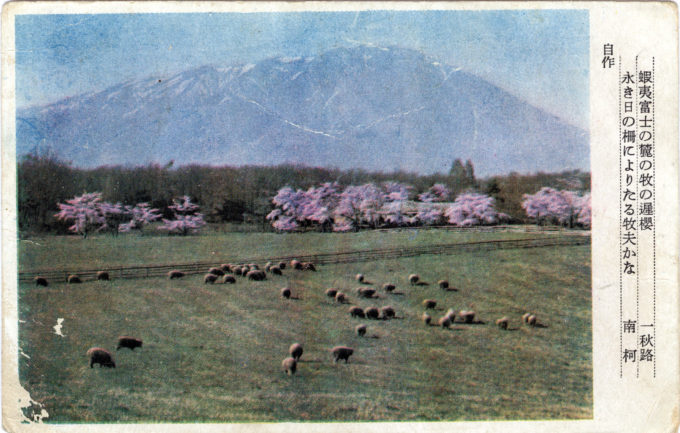“When I was in Hokkaido sheep were being experimented with at different places on the mainland, sheep buyers had gone off to Australia, New Zealand and South America, and a Tokyo Sheep Bureau of two dozen officials had been established.
“Great hopes were built on a few hundred sheep in Hokkaido. But I noticed that Government farm sheep were under cover on a warm September day. Also I heard of trouble with two well-known sheep ailments. There was talk nevertheless of the day when there would be a million sheep in Hokkaido, perhaps three millions.
“On the mainland I also met high officials and enthusiastic prefectural governors who dreamed dreams of sheep farming in Old Japan, where land is costly, farms small, agriculture intensive, grazing ground to seek, and farmland necessarily damp … The notion is that the wool and manure of a sheep would meet the expense of its keep and that the mutton would be a profit.”
– “Must the Japanese Make Their Own ‘Yofuku’ [foreign clothes]?”, by John William Robertson Scott, The Foundations of Japan: Notes Made During Journeys of 6,000 Miles in the Rural Districts as a Basis for a Sounder Knowledge of the Japanese People, 1922

Sheep grazing in the shadow of Ezo Fuji, Hokkaido, c. 1930. Also known as Mt. Yotei, which bears a resemblance to the iconic Mt. Fuji, “Ezo” (or “Yezo”) was an old name for the island of Hokkaido. The introduction of sheep into Japan dates from 1872 when the first half-dozen of the livestock were imported from the United States to the small Experimental Station at the Kaitakushi [Hokkaido Colonization Office] in Aoyama, Tokyo, with the goal of developing a domestic supply of wool for military uniforms and blankets rather than being dependent on foreign wool imports. In the 1920s, the Ministry of Agriculture and Commerce would establish an experimental sheep farm near Mt. Yotei (Ezo Fuji) southwest of Sapporo – now a part of Shikotsu-Toya National Park.
See also:
“The Five Stock Exhibition of Hokkaido,” c. 1920.
“It has been demonstrated that Yezo [Hokkaido] is capable of yielding good crops of hardy cereals and vegetables, that Japan is a country eminently adapted to support sheep and the finest breeds of cattle, and has a climate suited to develop to perfections cereals, leguminous plants, and artificial grasses, such as red and white clover, alfalfas, and the rye family.
“Time and steady perseverance are, however, needed before national success is achieved. It is gratifying to know that, in the improvememnt of this mother of all arts, Americans have been the pioneers, and have done so much and so well.
“Next to the uprooting superstition and gross paganism by pure religion and education, there is nothing more important for Japan than the development of her virgin land and the improvement of her ancient agricultural resources.”
– The Mikado’s Empire, by William Elliot Griffis, 1887


Pingback: Marugata (round-shaped) woolen shawl, advertising postcard, c. 1930. | Old TokyoOld Tokyo
Pingback: Hokkaido Semi-Centennial Exposition, 1918. | Old TokyoOld Tokyo